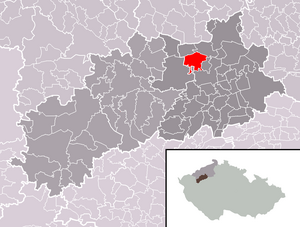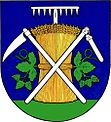Lenešice
| Lenešice | ||||
|---|---|---|---|---|
|
||||
| Basic data | ||||
| State : |
|
|||
| Region : | Ústecký kraj | |||
| District : | Louny | |||
| Area : | 1,371.3634 ha | |||
| Geographic location : | 50 ° 23 ' N , 13 ° 46' E | |||
| Height: | 182 m nm | |||
| Residents : | 1,432 (Jan 1, 2019) | |||
| Postal code : | 439 23 | |||
| License plate : | U | |||
| traffic | ||||
| Street: | Břvany - Louny | |||
| Railway connection: | Prague – Most | |||
| structure | ||||
| Status: | local community | |||
| Districts: | 1 | |||
| administration | ||||
| Mayor : | Karel Nováček (as of 2013) | |||
| Address: | Knížete Václava 521 439 23 Lenešice |
|||
| Municipality number: | 566322 | |||
| Website : | www.ou-lenesice.cz | |||
| Location of Lenešice in the Louny district | ||||

|
||||
Lenešice (German Leneschitz ) is a municipality in the Czech Republic . It is located three kilometers northwest of Louny and belongs to the Okres Louny .
geography
Lenešice is located at the southwestern foot of the Central Bohemian Uplands . The village is on the left side of the Hrádecký potok at its confluence with the Eger . To the north rises the Lenešický chlum ( Chlum , 297 m), in the northeast the Oblík (509 m) and the Červený vrch ( Red Mountain , 275 m), south of the Mělce ( Malletzer Berg , 223 m) and in the northwest of the Břvanský vrch ( Weberschaner Berg , 302 m). The Lenešický rybník pond is located northwest of Lenešice.
Neighboring towns are Poustka, Hradek and Raná in the north, Oblík, Chraberce and Nečichy in the Northeast, Dobroměřice the east, Louny in the southeast, Zeměchy in the south, Březno in the southwest, Seník, Postoloprty and Vrbka in the west and Výškov , Novy Dvur and Břvany in northwest .
history
The first written mention of the place was in 1226 as the property of the Doksany Monastery . In 1262 the Church of St. Simon and Judah was built. Since 1324 the village belonged to the estates of the Porta Apostolorum monastery . Several ponds were created in the 15th century. On June 10, 1535 Ferdinand I gave Sebastian Krabitz zu Weitmühl the villages of Wischkowa , Brzwany and Leneschitz. In 1592 Johann Czernin von und zu Chudenitz acquired the Lenešice estate. His successor Georg Czernin von und zu Chudenitz had the castle built. The castle was repaired in 1698 under Johann von Clary and Aldringen . In 1767 the castle was rebuilt. An economic boom followed under Jakob Wimmer, who acquired the estate in 1788. He promoted fruit growing and the cultivation of clover . Wimmer also had the southern part of the village green redesigned and the ponds drained. In 1797 the church cemetery was closed. In 1802 the princes of Schwarzenberg acquired the estate.
After the abolition of patrimonial Lenešice / Leneschitz formed a political municipality in the Louny district from 1850 . The village was on the Czech-German language border. The Kaiserstraße to Postelberg was built in 1861, replacing the old road via Nový Dvůr. The two pheasantries in the castle park were among the largest in Bohemia in the 19th century. After the breeding of pheasants was no longer profitable, the facilities were reduced by half in the 1860s and completely closed in 1887. In 1872 the Prague-Dux Railway put the Brüx-Chlumčany line into operation, which was continued the following year to Prague and in 1885 to Vltava . In 1893 the larger of the two ponds on the village square was filled in and a school was built on it. In 1899 the community received a train station. The plans to build another railway from Komotau via Postelberg , Lenešice and Leitmeritz to Bohemian Leipa were not implemented. In 1904 the small village pond was also drained. The estate belonged to the Prince of Schwarzenberg until 1925. In 1925 and 1938 the pheasantries were cleared. The community protested against it, unsuccessfully, because the former pheasant gardens served as an excursion destination. Instead, 25 hectares of pasture land were reforested east of it at Chlum. After the Munich Agreement , Lenešice became a border town with the German Empire. In the 1960s, the large pond Lenešický rybník was flooded again. Between 1981 and 1990 Břvany was incorporated. On July 3, 2008, a week before the start of repair work, the steeple of the Simon and Judah Church, which is a protected cultural monument, collapsed and tore half of the nave with it.
Community structure
No districts are shown for the municipality of Lenešice. Lenešice to include monolayer Ve Třesku, Novy Dvur, Poustka ( scrap mill ) and Seník ( Heuschuppe ).
Sons and daughters of the church
- Augustin Schránil (1878–1953), operetta composer
- Jan Miroslav Květ (1887–1961), musicologist
- Václav Kůrka (1912–1944), communist and resistance fighter against National Socialism
Attractions
- Church of St. Simon and Judah, built in 1262. Between 1800 and 1802 the church was rebuilt. On July 3, 2008, the church tower collapsed and half of the church was destroyed
- Lenešice Castle, built in 1599 for Georg Czernin von und zu Chudenitz
- Column with statue of St. Wenceslas, built in 1849
- Niche chapel of St. John of Nepomuk from the 18th century
- Rectory
- historical two-storey baroque warehouse by the pond
- Sugar factory, the 73 m high Esse is one of the highest octagonal chimneys in the country
- 160-year-old white poplar Linda Na brodech , the tree standing by the sugar factory in a bend in the Eger river, with a trunk circumference of 7.20 m, is the largest of its kind in the Czech Republic and is a protected tree monument.
Individual evidence
- ↑ http://www.uir.cz/obec/566322/Lenesice
- ↑ Český statistický úřad - The population of the Czech municipalities as of January 1, 2019 (PDF; 7.4 MiB)



